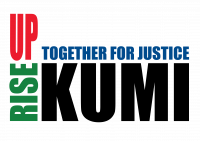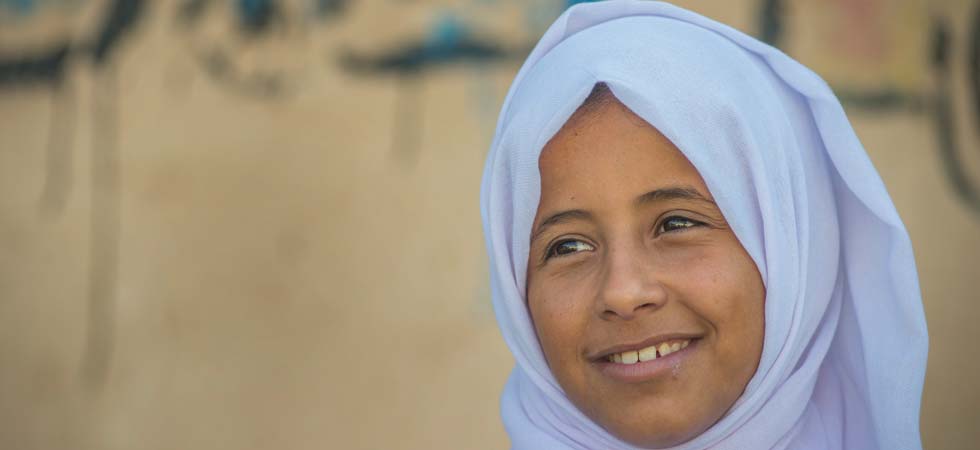Week 10: Women in Peacebuilding
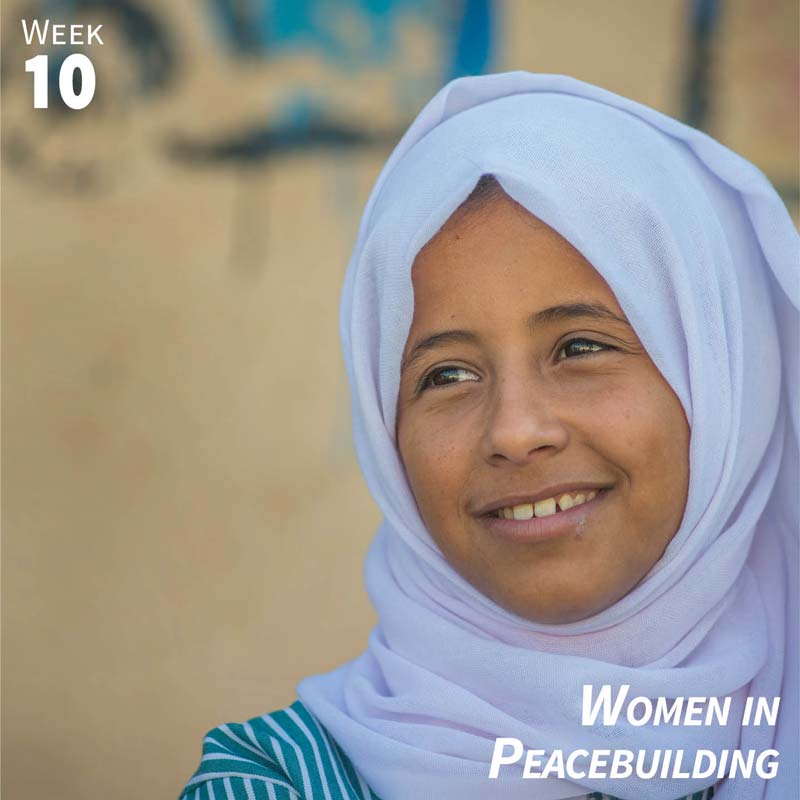
In other weeks of the year we document the hardships that women have had to bear due to the occupation. However, as the world celebrates International Women’s Day on March 8, we want to highlight the roles that women play in nonviolent resistance and the growing opportunities available to them in spite of the occupation. Here’s what you need to know and what you can do so that together we can rise up.
Topic: Women in Peacebuilding
In the fall of 2017 thousands of women across Israel and the West Bank marched for peace. This culminated in a two-week walk that wound through parts of Israel and the West Bank in the only land, Area C, where Israeli and Palestinian women may meet freely. The marches, shoulder to shoulder, through the desert near the Dead Sea, were remarkable for their size and for their collaboration between women from Palestine and Israel. The image of women from both sides marching together is a stark reminder of how intractable the conflict seems to many and of the broken status of the official peace process.
The marches were the work of Women Wage Peace, a grassroots peace movement that began after the 2014 Gaza War. Women uniting after violence primarily inflicted by men and resulting from the decisions of men is a common pattern, and Women Wage Peace was inspired by women’s movements in Liberia and other countries. Rabbi Donna Kirshbaum explains, “‘If it can happen there, it can happen here, too’ … ‘There’ for us was Liberia, where Christian and Muslim women united to oust a brutal dictator, ending a decades-long civil war.”
While the emergence of Women Wage Peace is a reason for hope and a reflection of growing grassroots collaboration between Palestinians, Israelis, and people around the world (of which Kumi Now is a part) it also provides an opportunity to reflect on past efforts, both successful and unsuccessful.
Giulia Daniele reflected on women’s movements in Israel and Palestine in 2014 in her book Women, Reconciliation and the Israeli-Palestinian Conflict: The Road Not Yet Taken. In interviewing hundreds of women from these movements, she found “the majority of women (she) interviewed have admitted the effective demise of joint Palestinian-Israeli politics that has missed its initial aims and practices, without achieving tangible gains. Indeed, although a few of them have not wanted to put a definitive end to such projects, the original idea of cooperation and mutual recognition has diminished in value with regard to its potential for carrying the prospect for a shared future between Palestinians and Israeli Jews forward.”
She continues, “When considering such forms of activism and making comparisons with those in Northern Ireland and South Africa, it must be borne in mind that several instances of direct action in Palestine/Israel have not fully achieved their initial objectives, although the majority of women activists have fought impressively hard to advance their participation and their role in the face of the violence and discriminations perpetrated by the dominant side.”
Daniela concludes that a big part of the problem has been “the illusory nature of the mutual cooperation between Palestinian and Israeli women.” Much of this came from the power imbalance between Israeli women and Palestinian women, with Israeli women approaching the divide from a standpoint of normalization and ignoring, or not being able to fully address, the effects of occupation on their Palestinian counterparts. But she finds hope in the non-violent actions led jointly by Israeli and Palestinian women focused on creating grassroots solidarity between the occupier and the occupied as opposed to top-down dialogue focused on political dialogues.
Women Wage Peace is just such a grassroots solidarity movement, but it is not alone, nor is it entirely unique. It joins many other women’s organizations that have championed grassroots solidarity, many of which were born out of previous cycles of violence and activism.
On both sides, today’s women’s movements mostly find their roots in an upsurge of activism in the 1980s. Israeli women, for example, started to unite in opposition to violence following war atrocities committed by the Israeli military against Palestinian refugees during the 1982 invasion of Lebanon, and Israeli organizations such as B’Tselem and Women in Black were founded during the First Intifada, which began in 1987. In Palestine, the First Intifada greatly increased the activism of women. They became increasingly political, often taking over leadership roles of men who had been killed or imprisoned.
Daniel Nerenberg writes, “Women’s gains during the Intifada spilled over into negotiations. When multilateral talks between Israel and the Palestinians began in Madrid in 1991, three Palestinian women joined, more female representation than any other delegation.”
However, “such advances were thwarted when exiled male PLO cadres negotiated an agreement with Israel behind closed doors. The Oslo agreements that followed were negotiated predominantly by those PLO members, sidelining the grass-roots Intifada activists who had effectively pressured Israel to the negotiating table in the first place. While female activists were arguably more connected to the needs and realities of Palestinians on the ground, the accords were ultimately negotiated entirely by men, excluding women not just from discussions, but also the process of government formation and eventually their central roles in civil society.”
It was yet another example of the politics of men sidelining women, and postmortem analysis of the failure of the Oslo agreements must include how women and grassroots organizations were excluded from the process.
At the same time, the advocacy of Palestinian women also moved to address gender issues, as if foreseeing how their contributions to the uprising would be overlooked, and how they would be expected to move aside when the men returned.
“Many women activists … were wary of entering the PA structures and placing too much emphasis on nationalist goals, fearing that this might eventually relegate women’s issues to the background. Instead, many founded their own independent feminist NGOs which often focus their work on strategic gender interests, lobbying the PA for women’s equal political and civil rights, but also addressing taboo topics, such as domestic violence, honour crimes, or the personal status laws (PSL). Among the more prominent women’s organisations are the Women’s Center for Legal Aid and Counselling (WCLAC), the Women’s Studies Center, Miftah, the Jerusalem Center for Women, the Arab Women’s Union, and In’ash al-Usra.” During this time, the Declaration of Principles on Palestinian Women’s Rights was published.
Acknowledging we can’t rewrite history, Nerenberg writes, “We don’t know what would have happened if more women had been included in negotiations after Madrid or during implementation following Oslo. But there is mounting evidence that greater inclusion of women in all stages of a peace process correlates with success in achieving and sustaining agreements. A study of 40 peace processes in 35 countries since the 1990s found that when women’s groups were heavily involved, agreement was substantially more likely than when women did not participate. In the post-agreement phase, influential women’s engagement resulted in longer-lasting peace.”
Nerenberg also notes, “Nonviolent resistance campaigns have historically been twice as successful as armed struggles, typically leading to more peaceful and democratic societies. Women’s participation is key to their overall effectiveness. One study found that movements that included gender equality in their discourse were dramatically more likely to adopt nonviolence. Other research has found that higher levels of women’s active participation in resistance campaigns correlates with greater nonviolent discipline and higher probability of achieving their stated aims.”
The United Nations has been well aware of this research, and acted accordingly. They passed the landmark Resolution 1325 in 2000 to reaffirm “the important role of women in the prevention and resolution of conflicts, peace negotiations, peace-building, peacekeeping, humanitarian response and in post-conflict reconstruction and stresses the importance of their equal participation and full involvement in all efforts for the maintenance and promotion of peace and security.” (See Week 43)
While we can’t rewind and rewrite history, including women as equal partners in conflict resolution, we can do so going forward. Unfortunately, as documented in Week 43, Israel’s policies of occupation and oppression target and degrade Palestinian women as much as ever. There is hope, however, in that the women’s movement within Palestine has made progress in challenging the Palestinian Authority’s patriarchal nature. Combined with the international community’s understanding of the importance of women in conflict resolution and the recent cooperation between Palestinian and Israeli women, this points towards a more stable and peaceful future.
However, to make this happen we all need to support these Palestinian and Israeli women’s organizations and efforts to pressure both the Israeli government and the PA to include women in decision making and conflict resolution. Kumi Now embraces both of these struggles, of women and Palestinians, and understands that their futures are inextricably linked. Throughout the week we will publish articles and stories highlighting this link, and promoting women’s organizations at the forefront of this struggle.
Story: Esraa Areer, journalist
A mother’s love is what motivated 25-year-old journalist Esraa Areer to cover the protests. In Areer’s case, however, it was the love for her homeland with which she was raised by her mother.
“My town of origin is Kfar Maimon, only a few kilometers from where I am standing [at the border]. Can you imagine the frustration I feel seeing my grandparents’ home yet unable to even step closer to it?” asked Areer. “Yes, as a journalist, I go to cover and document what is happening against my people, but my eyes are always far beyond the Israeli soldiers [trying to see my village].”
According to Areer, the only difference between the early days of the march and the present is that in the first months there were activities at the border multiple days of the week. Now, protests mostly are held just on Fridays. Areer emphasized the peaceful nature of the protests, estimating that 45–50 percent of the participants are women.
Areer was injured three times while reporting: twice by teargas and once by a rubber bullet in the knee She underwent surgery and now is unable to walk and thus resume reporting at the protests. Yet she is determined to return as soon as she is able.
“I can’t wait for the day when I am able to participate again,” she said firmly.
Entisar Abu Hasaneen shares Areer’s determination. She described women—especially mothers—as the source of men’s emotional strength. She encourages all the women in Gaza to continue to participate, confident that if women set this example, the men will follow.
“It is because of us (women) that the next generation is growing up with the love of their origins and their land,” she said. “No one creates love more than women.”
Esraa Areer’s story is told in Salsabeel Hamdan’s article “Women are Peaceful Face of Great Return March,” published by We Are Not Numbers at https://wearenotnumbers.org/home/Story/Gazan_Women_are_a_Peaceful_Face_of_the_Great_Return_March_. Check out https://wearenotnumbers.org/ for more stories written by Palestinian youth.
Kumi Action
We have written short profiles of seven strong Palestinian women and we are sharing them with you via the newsletter and on the website. Take these profiles and post them, one per day, on social media, or print them out and post them someplace others can see them.
Include a link to this page of the Kumi Now website along with the hashtags #IWD2022, #ChooseToChallenge, #PalestinianWomen, #KumiNow, and #Kumi10.
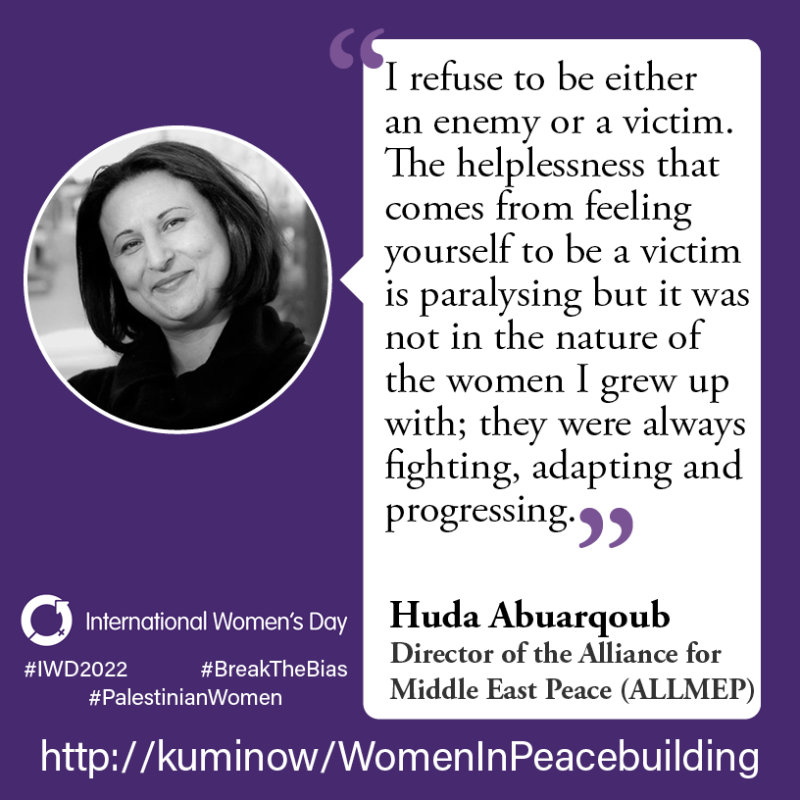
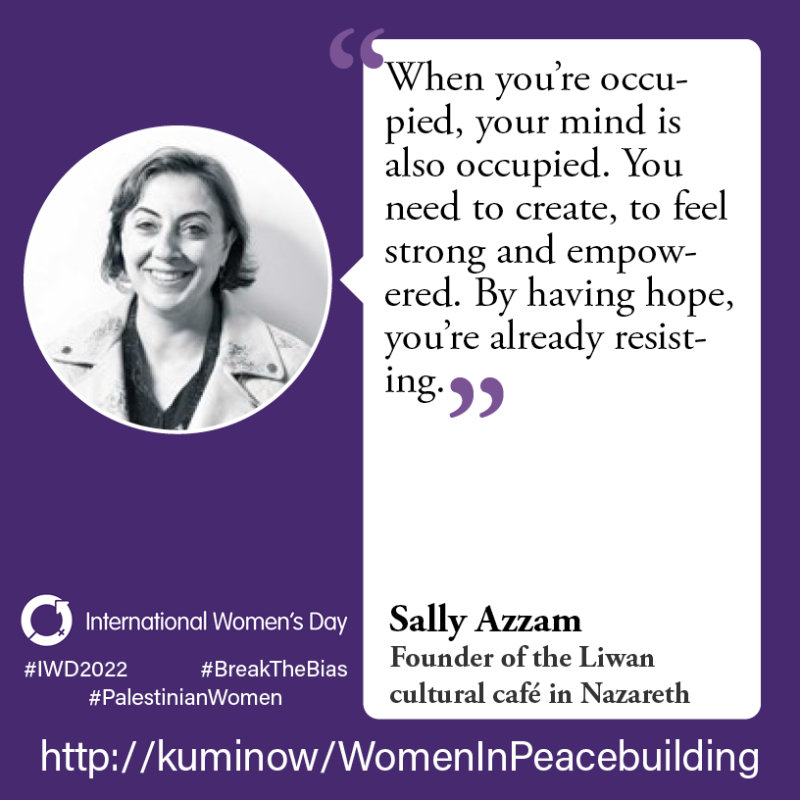
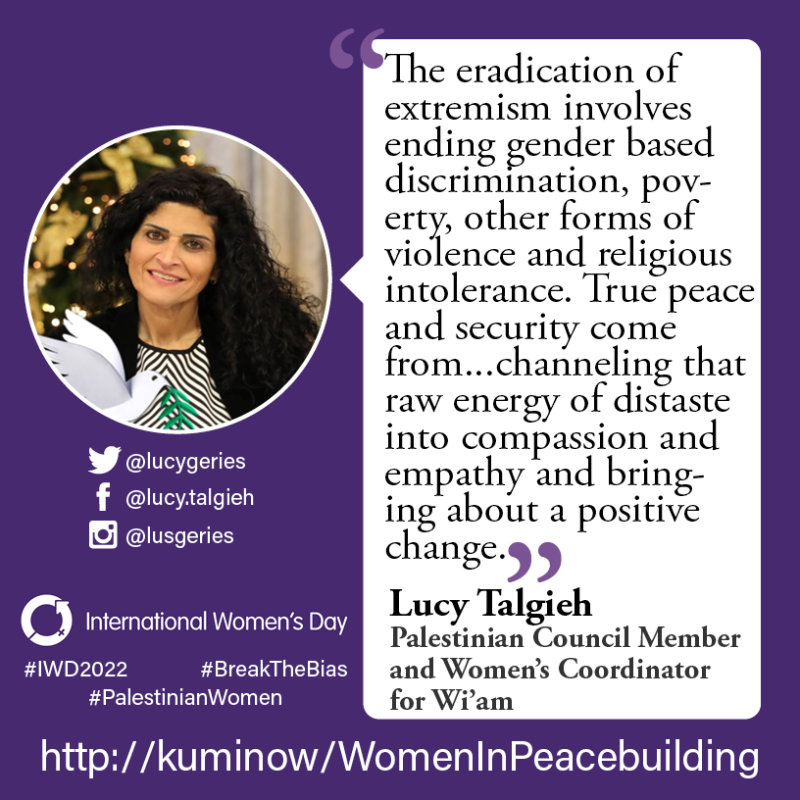
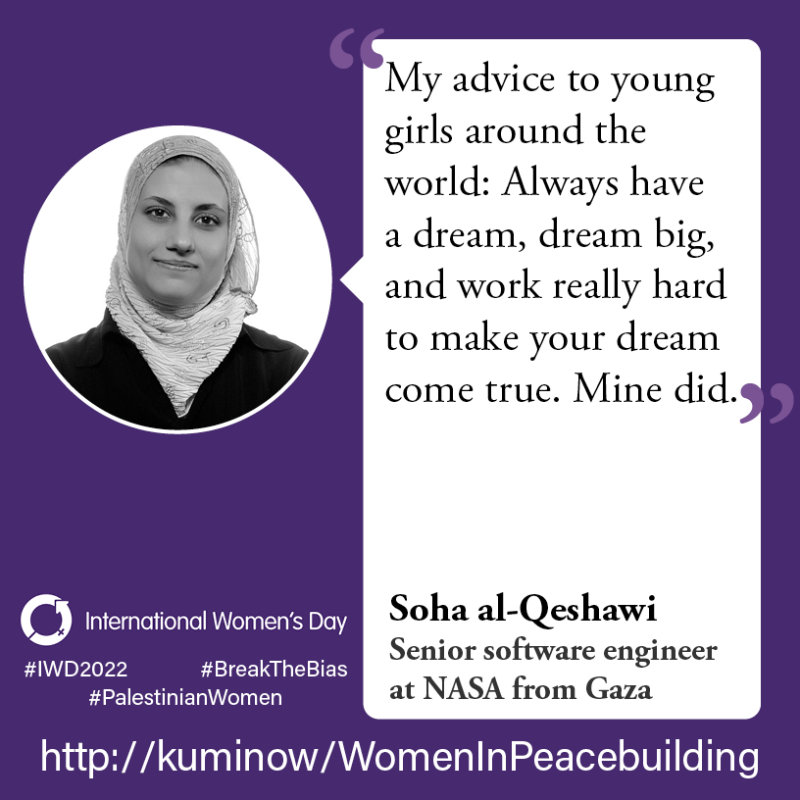
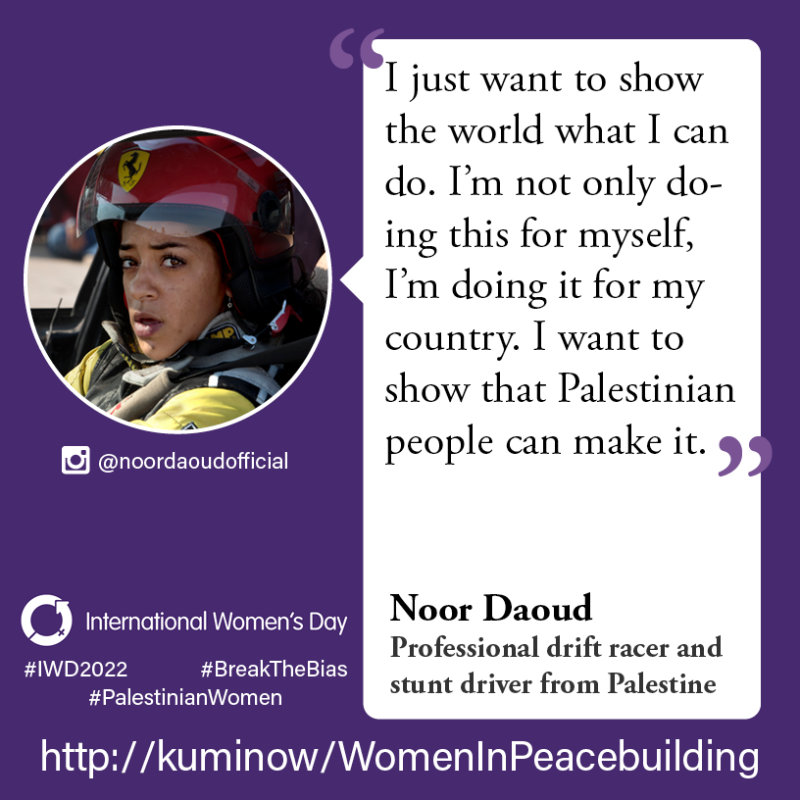

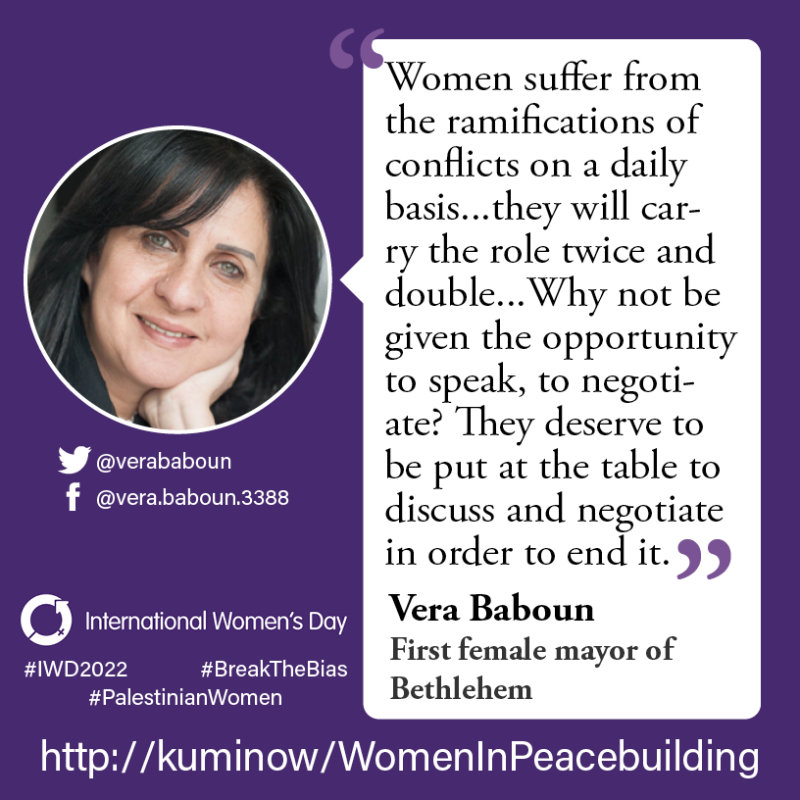
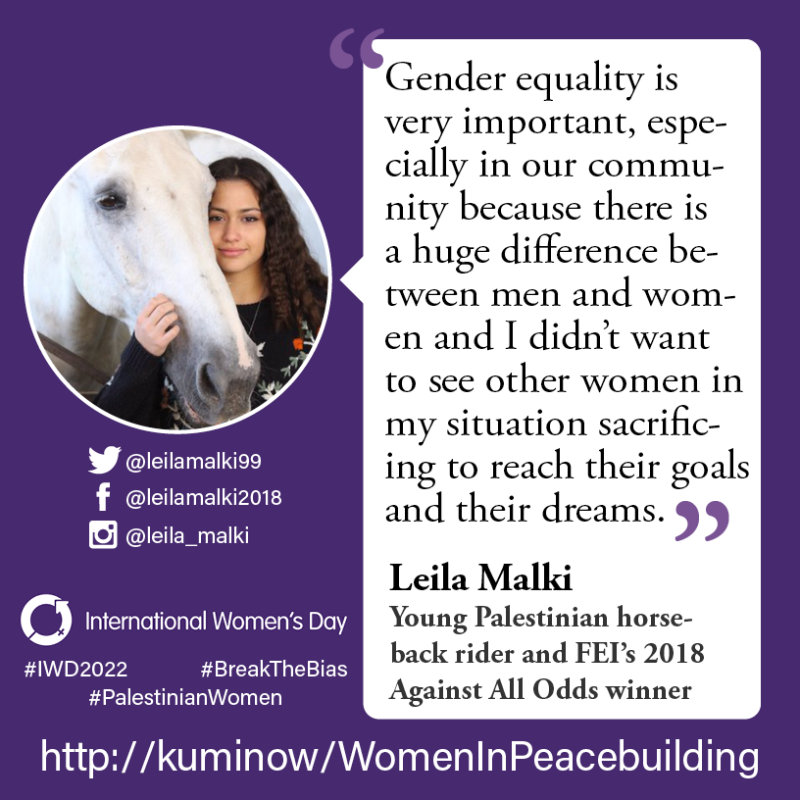
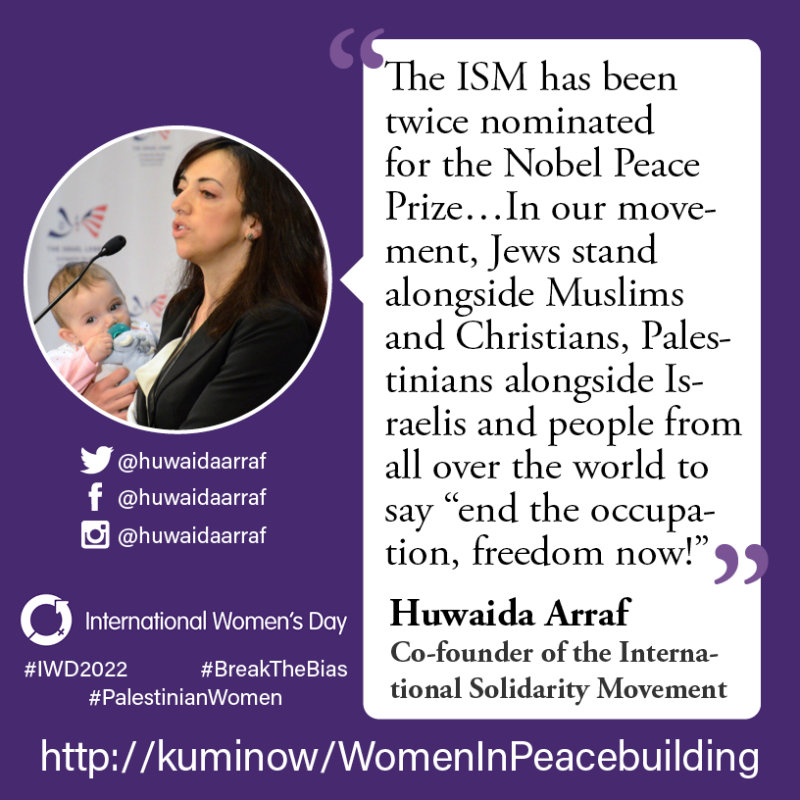
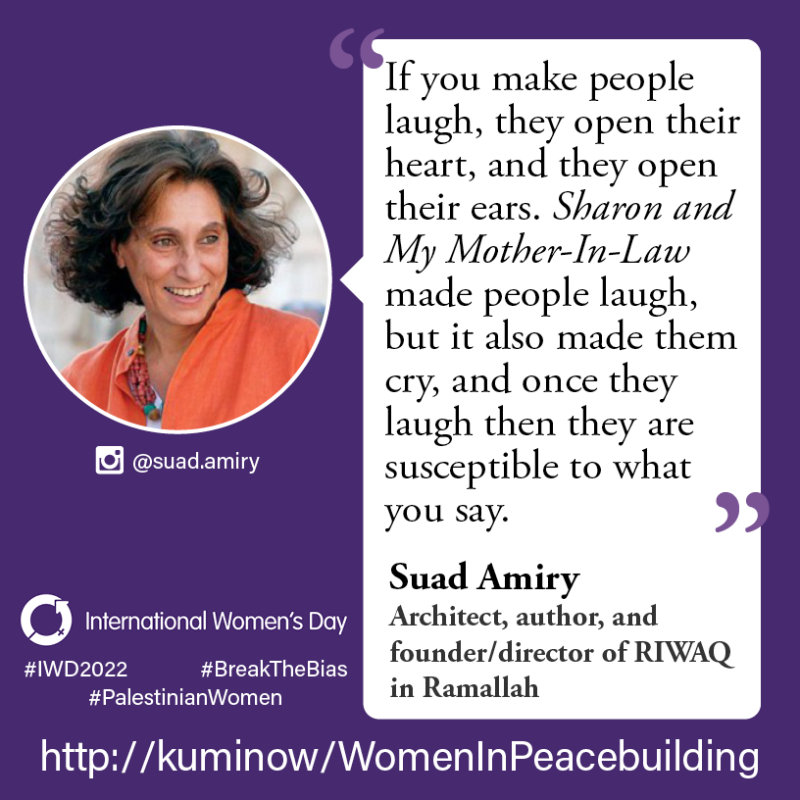
Literature: “The Words under the Words” by Naomi Shihab Nye
My grandmother’s hands recognize grapes,
The damp shine of a goat’s new skin.
When I was sick they followed me,
I woke from the long fever to find them
Covering my head like cool prayers.
My grandmother’s days are made of bread,
A round pat-pat and the slow baking.
She waits by the oven watching a strange car
Circle the street. Maybe it holds her son,
Lost to America. More often, tourists,
Who kneel and weep at mysterious shrines.
She knows how often mail arrives,
How rarely there is a letter.
When one comes, she announces it, a miracle,
Listening to it read again and again
In the dim evening light.
My grandmother’ voice says nothing can surprise her.
Take her the shotgun wound and the crippled baby.
She knows the spaces we travel through,
The messages we cannot send-our voices are short
And would get lost on the journey,
Farewell to the husband’s coat
The ones she has loved and nourished,
Who fly from her like seeds into a deep sky.
They will plant themselves. We will all die.
My grandmother’s eyes say Allah is everywhere, even in death.
When she talks of the orchard and the new olive press,
When she tells the stories of Joha and his foolish wisdoms,
He is her first thought, what she really thinks of His name.
“Answer, if you hear the words under the words
Otherwise it is just a world with a lot of rough edges,
Difficult to get through, and our pockets are full of stones.”
By Naomi Shihab Nye, a poet, songwriter, and novelist born to a Palestinian father and American mother. As published in the Anthology of Modern Palestinian Literature, edited by Salma Khadra Jayyusi.
Additional Resources
“Facts and Figures: Peace and Security” from UN Women https://www.unwomen.org/en/what-we-do/peace-and-security/facts-and-figures,
“Fact Sheet: The Global Study on 1325: Key Messages, Findings, and Recommendations” from UN Women https://wps.unwomen.org/resources/fact-sheets/Fact-Sheet-and-Key-messages-Global-Study-EN.pdf
“Israel and the Palestinian Territories Case Study: Current Peace Effort” from Council on Foreign Relations https://www.cfr.org/womens-participation-in-peace-processes/israel-and-palestinian-territories
“Preventing Conflict, Transforming Justice, Securing The Peace: A Global Study on the Implementation of United Nations Security Council resolution 1325” from the United Nations https://www.peacewomen.org/sites/default/files/UNW-GLOBAL-STUDY-1325-2015%20(1).pdf
